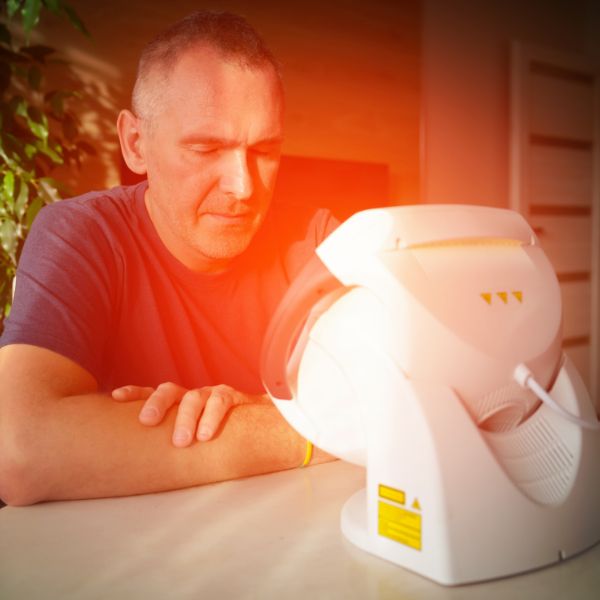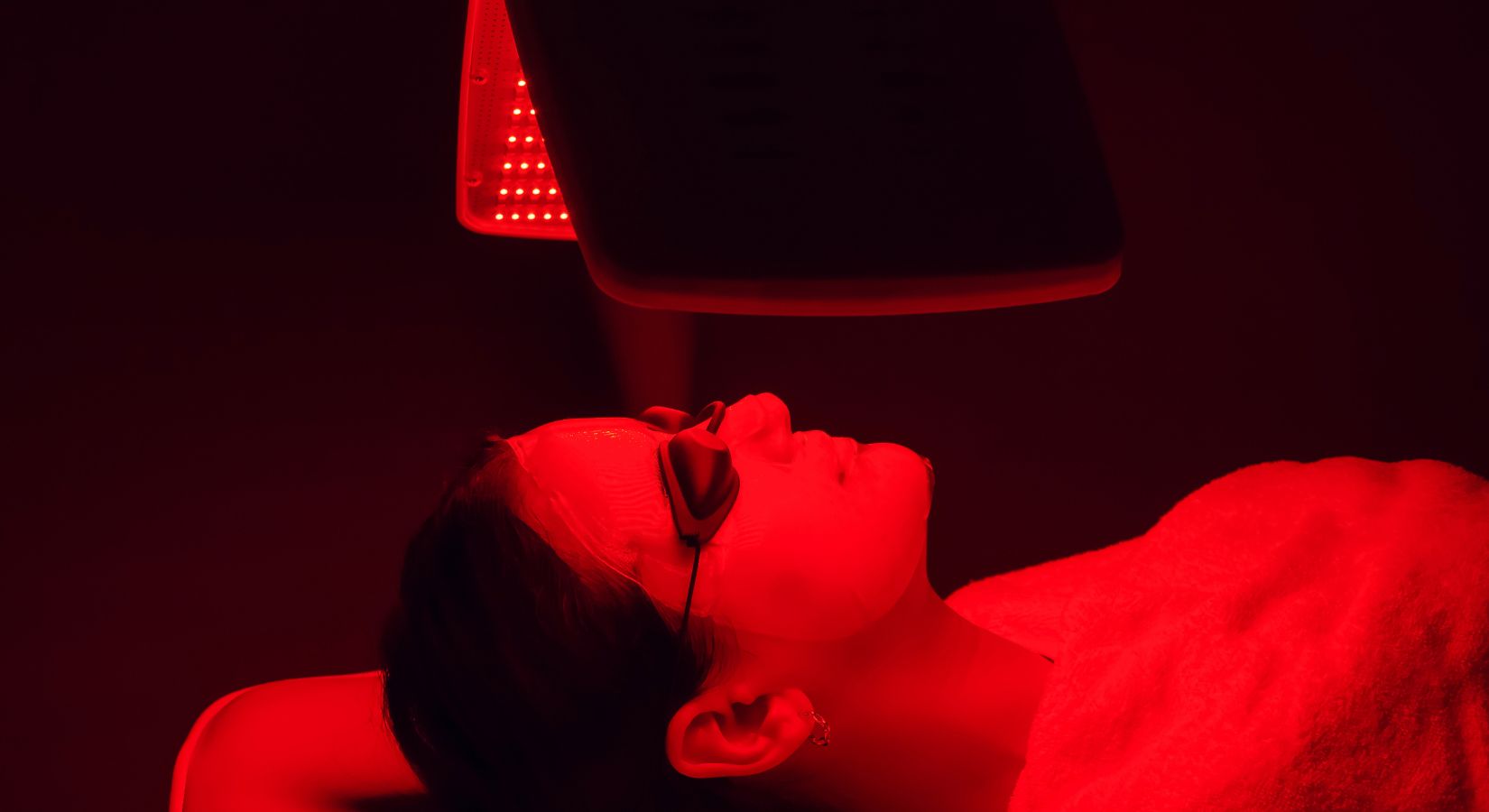If you’ve been curious about the benefits of red light therapy, welcome to the club! People have been using this natural treatment for a variety of medical conditions, from pain relief to skin care.
With its increasing popularity in the wellness community, more and more people are asking: does red light therapy work?
To answer this question, we need to take a closer look at the scientific evidence surrounding this powerful healing modality.
In this article, we will discuss the research behind red light therapy and provide an honest, science-backed answer to the question: does red light therapy really work?
What is Red Light Therapy?
Red light therapy (RLT), also called photobiomodulation, uses low-level red light wavelengths to promote healing and stimulate the body’s natural healing processes.
Red light therapy has been used for centuries in traditional Chinese medicine and Ayurvedic practices to treat a range of physical, mental, and emotional ailments.
Today, red light therapy is gaining popularity as a non-invasive and painless treatment option for many medical conditions.
Red light therapy is available in several forms such as handheld devices, led panels, and even face masks designed to help reduce inflammation, improve blood circulation, and stimulate energy production in cells. The benefits of RLT are literally skin deep, as the laser light works at the cellular level to heal the body.
How Does Red Light Therapy Work?

The technology behind red light therapy involves the skin’s photoreceptors, which absorb specific frequencies of light and convert them into energy.
The wavelengths of red light are able to penetrate deep into the tissue and help stimulate cell regeneration, which can help reduce inflammation and improve the look of wrinkles, sun spots, and other signs of aging.
Red light therapy also boosts collagen production, which can help improve skin texture and even out the skin tone.
In recent years, studies have suggested that red light therapy may be beneficial for treating a wide range of other issues such as chronic pain, weight loss, hair loss, muscle recovery, and even depression.
While more research is needed to determine the exact effects of red light therapy on these conditions, a 2014 research study by the Journal of Photomedicine and Laser Surgery suggests that RLT is a safe and effective way to improve overall health and wellness.
Does Red Light Therapy Work?
Yes! Red Light Therapy (RLT) is a safe, non-invasive way to naturally heal and rejuvenate the body.
Red and near-infrared light can penetrate tissue up to 10 millimeters, providing powerful antioxidant and anti-inflammatory benefits.
This healing form of light therapy has been used for years to treat numerous conditions, including pain relief, wrinkles, hair loss, stretch marks, muscle recovery, and more.
There are many scientific studies that back up its effectiveness. So, if you are looking for a natural remedy to improve your health and well-being, RLT could be a great option.
However, there are some drawbacks you should consider before using RLT. Let’s take a look at some of the advantages and disadvantages of such treatment.
Red Light Therapy Pros and Cons
Red light therapy is a relatively new therapeutic tool that has quickly become popular due to its potential health benefits. Despite the many benefits of red light therapy, it also comes with some potential drawbacks.
Pros:
- It is non-invasive, non-ablative, and painless
- Reduces inflammation and relieves pain
- Enhances skin texture and complexion
- Increases cellular energy production
- Treats muscle injuries
- Boosts immune system
- Improves circulation
Cons:
- Expensive treatment
- Potential for side effects like itching, redness, swelling, and burning sensation
- Limited research on its effectiveness for some conditions
- Not suitable for pregnant women or people with certain medical conditions
- May cause eye damage if done without the appropriate protective eyewear
Before attempting any form of red light therapy, it is imperative that you speak to your doctor to ensure that it is safe and effective for your specific condition.
Red Light Therapy for Weight Loss
Red light therapy is becoming increasingly popular as a weight loss aid. While it may seem too good to be true, there is evidence that this type of treatment can help with weight loss.
A 2015 study found that exercise combined with red light therapy was more effective at reducing fat mass when compared to normal psychical training. This is due to red light therapy’s ability to stimulate your metabolism and increase the burning of fat cells.
It also boosts energy levels and can help to reduce stress levels, leading to more effective and long-term weight loss.
While RLT is not a replacement for a healthy diet and exercise, it can be an effective tool for those trying to achieve their weight loss goals.
[Read: Red Light Therapy and Weight Loss: Does It Really Work?]
Red Light Therapy for Hair Loss
Hair loss is a common issue for men and women, due to various factors, such as hormones, medications, age, genetics, or nutrient deficiency.
Red light therapy may help to restore hair growth and reduce hair loss by stimulating blood flow to the scalp and increasing cell metabolism in the hair follicles.
Studies have suggested that regular red light therapy sessions may improve hair growth rate, thickness, and shine in those with thinning hair or alopecia.
It is also believed to reduce inflammation and protect the scalp from damage that can lead to baldness. Red light therapy may even help restore color to gray hair. However, more research is needed before conclusive evidence can be established.
[Read: 5 Benefits of Low-Level Laser Light Therapy for Hair Loss – Boost Hair Growth Naturally]
Red Light Therapy for Wrinkles
Red light therapy is a good option for people looking to reduce the signs of aging.
Studies have revealed that RLT can significantly improve the skin’s complexion and roughness, eliminating fine lines and wrinkles when used regularly.
The red light helps to stimulate collagen production and increase the skin’s elasticity. It also helps reduce inflammation and promote faster healing of damaged skin cells. Ideally, RLT should be used three to four times weekly for several months.
[Read: 6 Amazing Benefits of Infrared Light Therapy for Wrinkles]
Red Light Therapy for Stretch Marks
Stretch marks are a common problem, affecting up to 80% of women and men. Red light therapy may be an effective solution for reducing the appearance of stretch marks. This type of therapy utilizes red and near-infrared light to stimulate healing in the skin.
Red light penetrates deep into the skin to promote collagen production, reducing the appearance and texture of stretch marks.
Consult a professional before trying red light therapy for stretch marks. They will be able to evaluate the severity of your stretch marks and suggest the best treatment plan for you. This may include several sessions of red light therapy or a combination of other treatments.
Bear in mind that results may take several weeks or even months to become apparent. However, with dedication and consistency, RLT is a safe and effective way to reduce the appearance of stretch marks.
[Read: How to Use Red Light Therapy for Stretch Marks]
Red Light Therapy for Muscle Recovery
Red light therapy reduces inflammation and pain associated with muscle growth and speeds up healing. It can also improve the circulation of blood and oxygen, which are equally crucial for growing robust muscles.
If you are an athlete or someone who engages in high-intensity activities you might want to take note of this next benefit.
Red light therapy can help speed up recovery, which allows you to get back to your workout routine faster, making your training sessions 10x more effective!
The Journal of Laser Therapy published a study where 395 injuries including hamstring strains, knee sprains, and ligament damage, were treated with an 830 nm LED light for a US track team. The athletes did 2 to 6 sessions daily over a period of four months.
Participants experienced a 50% recovery time reduction within 9 days compared to the usual recovery time of 19 days. The athletes also reported relief from pain and inflammation associated with the heating sensation of RLT during treatment sessions.
In summary, RLT is highly beneficial for those looking to improve muscle recovery and experience better overall workouts.
Red Light Therapy for Depression
Depression is a serious mental health issue, and those who suffer from it need all the help they can get. Red light therapy has been gaining attention as a potential treatment for depression, due to its ability to affect hormone and neurotransmitter levels.
Studies have found that red light therapy increases serotonin and noradrenaline levels, which are both vital in regulating mood. Research also suggests that red light therapy may help reduce symptoms of anxiety and depression, as well as improve overall mood.
While more research is needed, red light therapy is becoming increasingly popular as a form of alternative treatment for depression.
[Read: Red Light Therapy for Depression: The Newest Treatment Option]
Bottom Line
Red light therapy is an exciting, natural way to improve your health and beauty without resorting to invasive treatments or harsh chemicals. While there’s still a lot of research to carry out, there’s promising evidence that it can help with a variety of conditions. Whether your goal is to reduce wrinkles, treat depression, or speed up muscle recovery, red light therapy may be worth considering.
Have you tried red light therapy? What was your experience? Let us know in the comments!
References
Ann Dermatol. (2021, November 4). Hair growth promoting effects of 650 nm red light stimulation on human hair follicles and study of its mechanisms via RNA sequencing Transcriptome analysis. PubMed Central (PMC). https://www.ncbi.nlm.nih.gov/pmc/articles/PMC8577899/
Corliss, J. (2022, October 28). Light therapy: Not just for seasonal depression? Harvard Health. https://www.health.harvard.edu/blog/light-therapy-not-just-for-seasonal-depression-202210282840
J Biophotonics. (2017, December 1). Photobiomodulation in human muscle tissue: An advantage in sports performance? PubMed Central (PMC). https://www.ncbi.nlm.nih.gov/pmc/articles/PMC5167494/
Journal of Laser Therapy. (2016, March 31). 830 nm light-emitting diode (led) phototherapy significantly reduced return-to-play in injured university athletes: A pilot study. PubMed Central (PMC). https://www.ncbi.nlm.nih.gov/pmc/articles/PMC4846838/
Lasers Med Sci. (2017, September 12). Effect of wavelength and beam width on penetration in light-tissue interaction using computational methods. PubMed Central (PMC). https://www.ncbi.nlm.nih.gov/pmc/articles/PMC5653719/
Lasers Surg Med. (2014, August 1). Low-level laser therapy for fat layer reduction: A comprehensive review. PubMed Central (PMC). https://www.ncbi.nlm.nih.gov/pmc/articles/PMC3769994/
Lasers Surg Med. (2015, July 29). The potential of phototherapy to reduce body fat, insulin resistance and “metabolic inflexibility” related to obesity in women undergoing weight loss treatment. PubMed.
Parry, B. L. (2003, December 5). Light treatment of mood disorders. PubMed Central (PMC). https://www.ncbi.nlm.nih.gov/pmc/articles/PMC3181775/
Saunas, C. I. (2021, June 24). The ancient history of color light therapy. Clearlight Infrared Saunas. https://infraredsauna.com/blog/color-light-therapy-history/
Tafur, J., & Mills, P. J. (2008, August 26). Low-intensity light therapy: Exploring the role of redox mechanisms. PubMed Central (PMC). https://www.ncbi.nlm.nih.gov/pmc/articles/PMC2996814/
University of Arizona. (n.d.). The effect of light therapy on chronic pain. ClinicalTrials.gov. https://clinicaltrials.gov/ct2/show/NCT03677206
Wunsch, A., & Matuschka, K. (2014, February 1). A controlled trial to determine the efficacy of red and near-infrared light treatment in patient satisfaction, reduction of fine lines, wrinkles, skin roughness, and intradermal collagen density increase. PubMed Central (PMC). https://www.ncbi.nlm.nih.gov/pmc/articles/PMC3926176/
